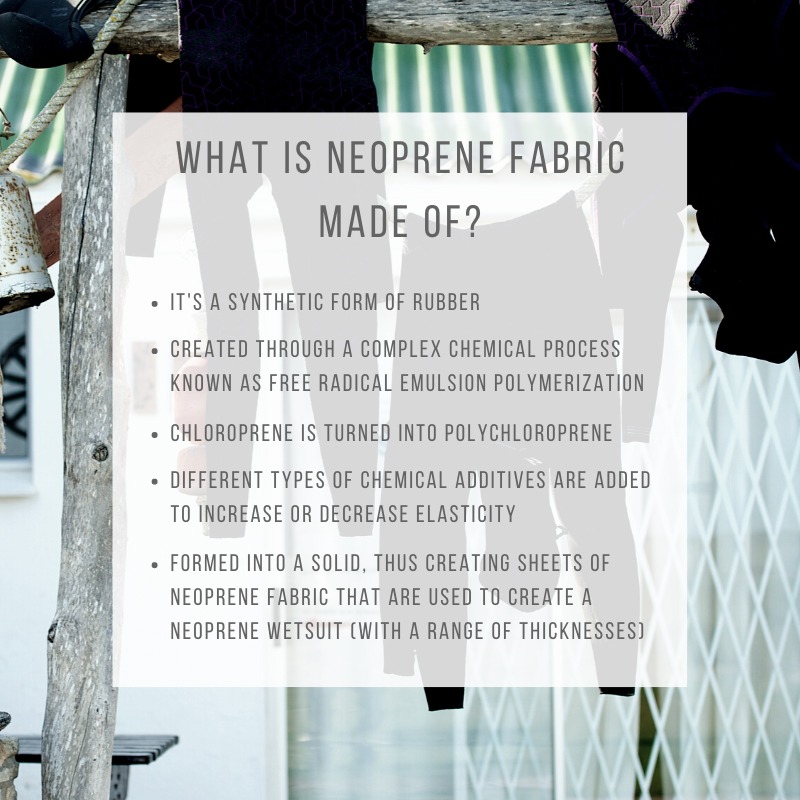What Is Neoprene Fabric Made Of?
Hannah Brown July 15th, 2020 Posted In: Articles
What Is Neoprene Fabric Made Of?
If you are new to the world of wetsuits all the jargon around neoprene fabric can be a little bit overwhelming. We don’t want you to make an uninformed decision, so let’s break it down.
What Is Neoprene?
In the early 20th century, rubber was in short supply, and many companies were hurting because of it. In the 1930s chemists were hired by the American DuPont Corporation in an effort to combat the shortage of rubber. From these efforts, a synthetic form of rubber was created and became known as Neoprene.
While both neoprene and rubber are polymers, neoprene actually ended up becoming more useful than rubber. Unlike rubber, neoprene is resistant to grease and oil, has superior heat resistance, and is able to endure more extreme temperatures and environments.
This new substance was created and designed to be water-resistant which made it a great option for wetsuits. While neoprene is the main substance in wetsuits, it is not the only substance used. There are various components that go into creating neoprene fabric to make sure you stay warm and comfortable.
What Is Neoprene Made Of?
Neoprene fabric is created through a complex chemical process known as free radical emulsion polymerization. Basically this process takes normal chloroprene and turns it into the synthetic version known as polychloroprene. Essentially what this means is that the fabric is created by turning a liquid into a solid.
 What Is Neoprene Fabric?
What Is Neoprene Fabric?
When the fabric is in a liquid form, different additives are used to increase or decrease the elasticity of the fabric to create the perfect middle ground. When this fabric is turned into a solid it has to be baked into a “loaf” and then sliced like bread.
The thickness of a slice is what determines how waterproof and insulated the fabric becomes. This is essential for the creation of wetsuits which can range from very insulated (.7mm slice) to regular insulation (.3-.5mm slice). These slices are then sent off to manufacturers who create clothing and other objects out of these slices.
Why Neoprene?
There are a few reasons why neoprene was chosen as the fabric for wetsuits. It is impermeable, elastic, insulating, it is formable, and it is buoyant.
Impermeable
Neoprene, unlike many other types of fabrics, is not permeable. There are no small holes that allow water or other elements to flow through. This means that any outside elements are not able to reach your skin when you are wearing neoprene fabric. This is perfect for athletes who want to go swimming in cold water. The only time water seeps through neoprene is either via the seams or when it flushes through the neck, wrists, and ankles.
Elastic
Despite being impermeable, neoprene is quite durable and elastic. This allows you to get a snug fit, while still being able to get into your wetsuit.
Insulation
During the process of neoprene fabric creation, a layer of nitrogen bubbles becomes trapped inside the fabric. These nitrogen bubbles act as a heat insulator and keep you warm. This is perfect for the creation of wetsuits where the neoprene keeps athletes warm.
Wetsuits are typically created with three different layers of fabric. The layer closest to your body is a heat-reflecting material (such as fleece, polyester, nylon, or kevlar), then there is the neoprene layer, and then the outer layer is made from a water-resistant or abrasion-resistant material.
Formability
While most fabrics are woven together to create clothing, neoprene is cut and formed into shapes. This allows for a wider variety of styles, shapes, and sizes.
Buoyancy
Due to the tiny nitrogen bubbles trapped in the neoprene, the fabric tends to be very stretchy and lightweight.
All of these reasons are what make neoprene so ideal for any form of water sport. Neoprene fabric is found in wetsuits, swimsuits, swimming gloves, fishing wear, and even golfing jackets. It is popular with those who jet ski, windsurf, surf, and for some elite athletes training for races.
Neoprene Cons
In almost every case, neoprene is the superior fabric when it comes to wetsuit manufacturing, except when it comes to environmental impact. Because neoprene is a synthetic man-made fabric there are many chemicals that go into its creation. The waste produced from the creation of neoprene and the increased time it takes neoprene to decompose is often seen as the sole con of neoprene.
Thankfully, brands like Patagonia have developed a line of wetsuits that are renewable and much more environmentally friendly. Not only is it environmentally friendly, but if you have neoprene allergies it is less likely to cause skin irritation.

